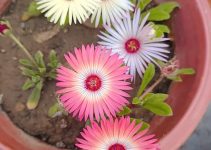Sage
Salvia officinalis
You just can’t overdo sage in the garden. This perennial herb earns its keep with fast-growing ways, beautiful blooms, and a flavor deer find distasteful. Once established, plants shrug off drought, although it’s wise to keep plants well-hydrated through the hottest parts of summer if you want a steady supply of supple foliage.
Some gardeners pinch out flower buds to keep leaves forming, but the blooms are beautiful. If you choose to let plants flower, when blossoms fade, cut plants back to beneath where flower buds formed. Don’t cut back to woody stems that have no leaves; those most likely won’t sprout again. Sage plants typically require replacing every 3-4 years, as plants become woody and produce fewer leaves.
The uses of sage are beyond measure. Besides its popular use as a culinary herb, sage is also commonly pressed into service in cosmetics, perfumes, and soaps. Some naturalists rub it on their skin as an insect repellent. Hanging dried leaves among woolen clothing deters moths. Burning sage removes unpleasant odors, such as lingering cigarette smoke or cooked fish smells.
Light: Part sun, Sun
Type: Herb, Perennial
Height: Under 6 inches
Width: 24-36 inches
Flower color: Blue, Pink, White
Foliage color: Blue/Green
Seasonal features: Fall bloom, Spring bloom, Summer bloom
Problem solvers: Deer resistant, Drought tolerant
Special features: Fragrance, Good for containers, Low maintenance
Zones: 4-10
How to Grow Sage Plant Indoors
Learning how to grow sage plant indoors is not difficult when you understand that lots of light is necessary for successfully growing sage indoors. A sunny window with several hours of sunlight is a good start whenever you are growing sage in containers. Likely though, the sunny window will not give potted sage plants enough light to flourish abundantly. Therefore, supplemental lighting can improve the situation and is often necessary for the care of potted sage herbs.
Sage needs six to eight hours of full sun daily. If your sunny window does not provide this much daily sun, use fluorescent lighting when growing sage indoors. A double fluorescent tube mounted under a counter top, without cabinets underneath, can provide the perfect spot for sage in containers. For every hour of sunlight required, give growing sage indoors two hours under the light. Place the potted herb at least 5 inches from the light, but no further away than 15 inches. If artificial light alone is used when growing sage in containers, give it 14 to 16 hours daily.
Care of Potted Sage Herbs
Successfully learning how to grow sage plant indoors will include using the right soil too. Sage, like most herbs, does not require a rich and fertile soil, but the potting medium must provide good drainage. Clay pots assist in drainage.
As part of your care of potted sage herbs, you will need to keep the plants in a warm area, away from drafts, in temperatures around 70 F (21 C.). Provide humidity when growing sage indoors, with a nearby pebble tray or humidifier. Including other herbs in containers nearby will also help. Water as needed, letting the top inch of soil dry out between waterings.
When using fresh herbs, use two to three times more than when using herbs that are dried and harvest the herbs often to encourage growth.
Now that the question “Can sage be grown indoors” has been answered, give it a try for use in Thanksgiving and Christmas meals.


